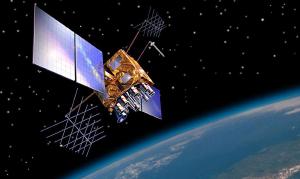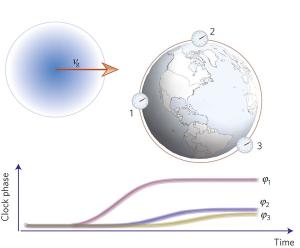Blog
A Matter of Time
19 November 2014
 US National Executive Committee for Space-Based Positioning, Navigation and Timing
US National Executive Committee for Space-Based Positioning, Navigation and TimingThe global positioning system (GPS) is an array of satellites orbiting the Earth, which can be used to pinpoint your location. Each of the satellites transmits a signal with its current position and time. A GPS receiver can then use signals from multiple satellites to determine where it is on the planet. GPS is perhaps most widely used in mobile phones. If you’ve ever had your phone give you directions, you’ve used GPS. In order to work properly, the clocks on a GPS satellite need to be extraordinarily precise. So precise that the effects of special and general relativity must be taken into account.
In special relativity, the motion of an object relative to you causes the apparent time of that object be slower. Since the GPS satellites are orbiting the Earth, their clocks seem slower to us. In general relativity, a clock in the presence of a gravitational field run a bit more slowly than one without. Since the gravity at the surface of the Earth is a bit stronger than at the GPS orbits, the clocks of the satellites seem a bit faster to us. When you combine these two effects you get that the GPS clocks run too fast by about 38 microseconds a day. In order to correctly position objects on Earth we need a precision of about 20 nanoseconds a day, which is more than 1,000 times more precise. The GPS clocks are adjusted to account for time dilation, so that they broadcast Earth-time, not their local time. So every time you use your phone to locate the nearest bookstore you are utilizing technology that absolutely depends on relativity.
 A. Derevianko & M. Pospelov
A. Derevianko & M. PospelovSince the GPS clocks are so precise, any fluctuation in the gravity around Earth would affect their timing in a small way. This led to a new idea published in Nature Physics, that proposes using GPS to detect dark matter.1 As many of you know, dark matter is that mysterious type of matter that doesn’t interact strongly with light. There’s a lot of evidence to support its existence, ranging from gravitational lensing to the large scale structure of galaxy clusters, but we’ve never detected it directly, so we aren’t entirely sure what it is. There have been lots of proposed ideas, ranging from the ever popular WIMPs to exotic particles such as axions, to primordial black holes.
This paper considers an even stranger dark matter candidate known as topological dark matter. Most dark matter consider the stuff to be some type of particle. These would interact gravitationally to clump on galactic and intergalactic scales, but not on smaller scales. With particle models there simply isn’t enough gravitational warping by dark matter to have a measurable effect. In fact, studies of stars within about 1,000 light years of Earth shows no net gravitational effect from dark matter, which (somewhat counterintuitively) is what we would expect.
Topological dark matter (also known as top down dark matter, or TD) is very different. Instead of being some kind of strange particle, TD matter is generated by topological defects in space and time. The idea is based upon the cosmic string model (not to be confused with string theory). To use a very rough analogy, as water freezes to ice, cracks can form at the intersection between two regions of the water that started to crystallize. In a similar way, during the inflationary period of the early universe, different sections of spacetime “freeze” into their current state, leaving cosmic strings like cracks in the fabric of spacetime. In the TD model, these cosmic strings can gradually decay to create various particles, including dark matter.
Because these topological defects are localized in space, newly created dark matter would tend to clump around it. Such a clump would distort space and time around it. Not much, but enough to be measured with precise clocks such as those in GPS. In this new paper, the authors look at how GPS clocks would be affected by a clump of TD dark matter that happens to pass near Earth. What they find is that it could have a measurable effect.
Just to be clear, there’s no evidence of cosmic strings and the like, so topological dark matter is a bit speculative. However given the number of dark matter candidates that have been eliminated, it is definitely worth checking out. What’s particularly clever about this idea is that it doesn’t require the construction of a new dark matter detector. The advanced lab is already orbiting Earth. All we need to do is analyze data that’s already there, which the authors have started doing.
So it’s possible that finding dark matter may simply be a matter of time.
Derevianko, Andrei, and Maxim Pospelov. “Hunting for topological dark matter with atomic clocks.” Nature Physics 10.12 (2014): 933-936. ↩︎